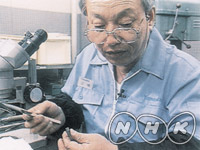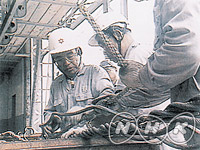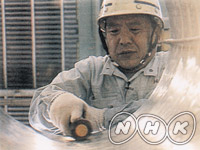Science and Technology
![]()
- Master Craftsmen in High Technology
-
ハイテクの職人たち [NHK]
 Old Skills for New Integrated Circuits
Old Skills for New Integrated Circuits
DC299812![]()
ハイテクの職人たち | 竹串でつくる集積回路 [NHK]
![]()
![]()

|Length : 10min. |Year : 1998 |
As technology has advanced, many firms have had to adjust by developing new products. One such company in Kyoto has switched from the manufacture of metal molds for automobile parts to high-precision molds for integrated circuits. Mr. Ebata's job is "mirror polishing," and he employs a wide range of tools, including willow wood and bamboo skewers. His skills in precision processing are essential, and it's just one example of how skills from an earlier era are now being employed in new, cutting-edge technology.
 Steel Cable Braiding
Steel Cable Braiding
DC299811![]()
ハイテクの職人たち | ワイヤーロープは手でつなげ [NHK]
![]()
![]()

|Length : 10min. |Year : 1998 |
Mr. Ugajin (74) and Mr. Suzuki (72) are among only a handful of people in the country who possess the skills and experience necessary to braid steel cables - used in construction of massive bridges and ski-lift equipment and requiring a high level of safety - into continuous loops. This work is done manually as it requires a sure hand and a well-trained eye that machines do not have. This episode focuses on these two senior citizens as they pass their skills on to the next generation of cable braiders.
 Polishing Rainbows, Manipulating Light
Polishing Rainbows, Manipulating Light
DC299810![]()
ハイテクの職人たち | 虹を磨く 光を操る [NHK]
![]()
![]()

|Length : 10min. |Year : 1998 |
The production of finely-tuned optical lenses and prisms - used in cameras, telescopes and semiconductor manufacturing equipment - necessitates the sensitive touch of the human hand. Akira Hozumi produces prototype optical lenses and pentaprisms, which then become the standard for mass-produced goods. He uses his hands, fingertips and a sense of timing and intuition that has been honed over the years to produce these articles, some with angles to within 1/360 of a degree.
 Nimble Fingers for Fashion
Nimble Fingers for Fashion
DC299809![]()
ハイテクの職人たち | 最新ファッションを生む指先の技 [NHK]
![]()
![]()
![]()

|Length : 10min. |Year : 1998 |
The shape of a particular fiber determines its distinctive qualities, and central to the distinctiveness of each fiber is the precision of the holes, which can be as small as 100 microns, through which petroleum-based materials are squeezed to become chemical fibers. Akinori Katayama has been designated a "modern master craftsman" by the Ministry of Labor. He files and polishes unique tools made of ultra-hard alloys up to the thickness of a strand of human hair that are used to drill these holes into nozzles.
 Giant Propellers
Giant Propellers
DC299808![]()
ハイテクの職人たち | ミクロの研磨 巨大スクリュー [NHK]
![]()
![]()
![]()

|Length : 10min. |Year : 1998 |
This episode focuses on the process of making giant ship propellers - from the initial stage when the copper alloy is cast into the mold, through the final steps which require manually planning the hole in the propeller where the shaft must be snugly fitted, to the hand polishing of the giant blades. These "human touches" ensure that the ships which transport goods around the world can journey efficiently and safely. To paraphrase Mr. Izutani who has been doing this job for 25 years: "Humans are still superior to machines."














